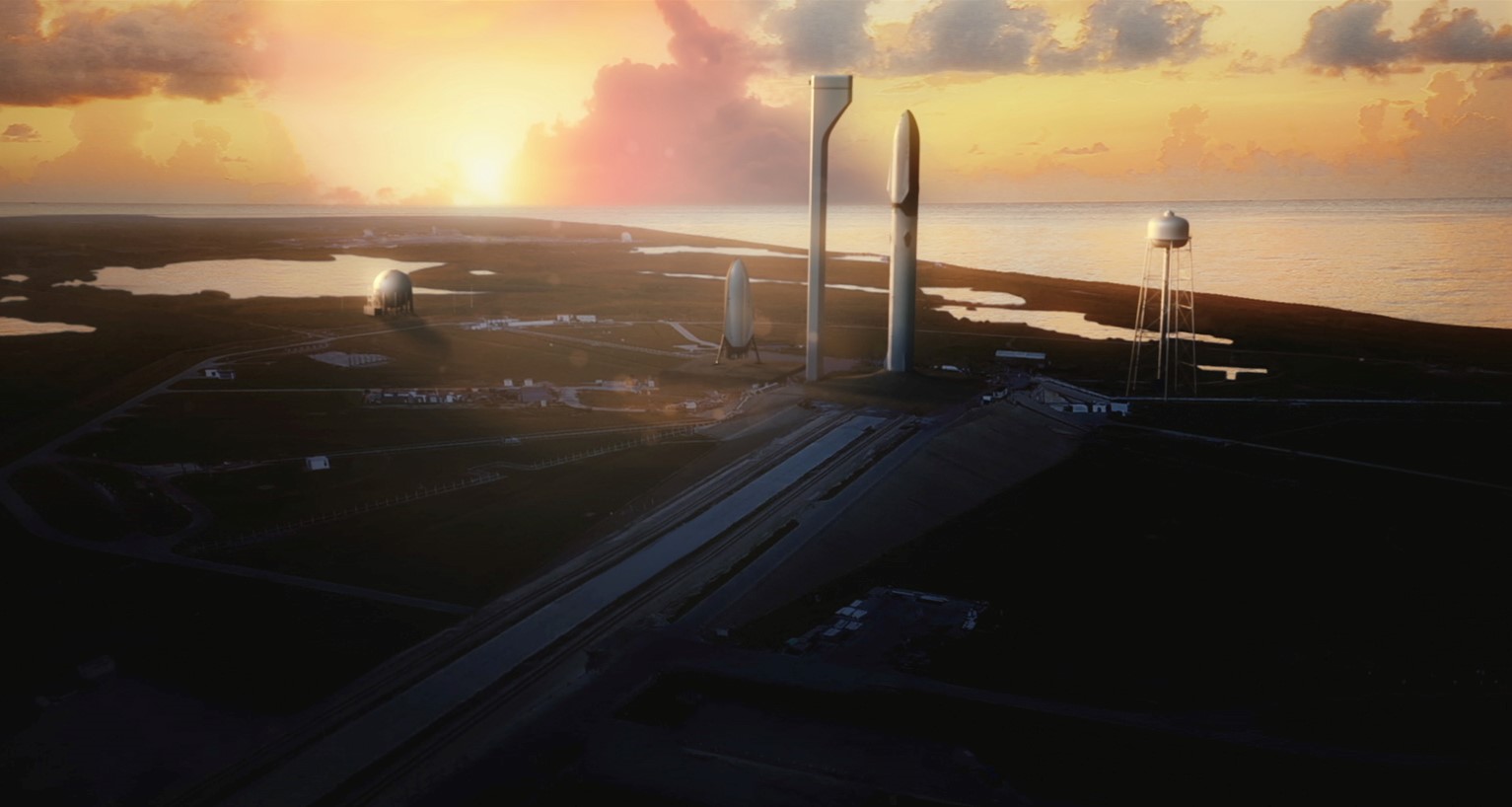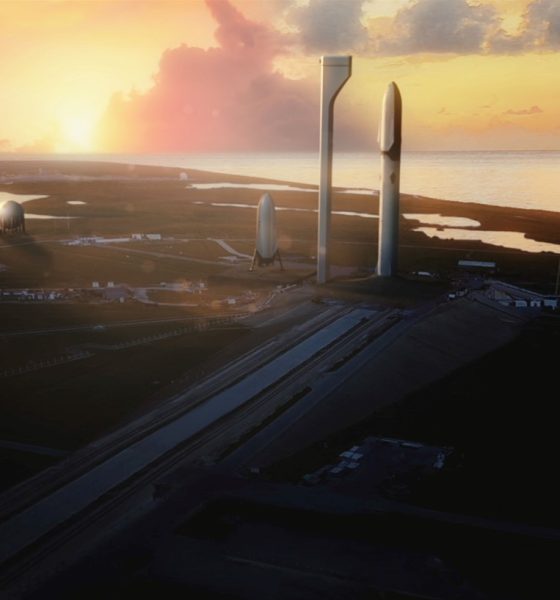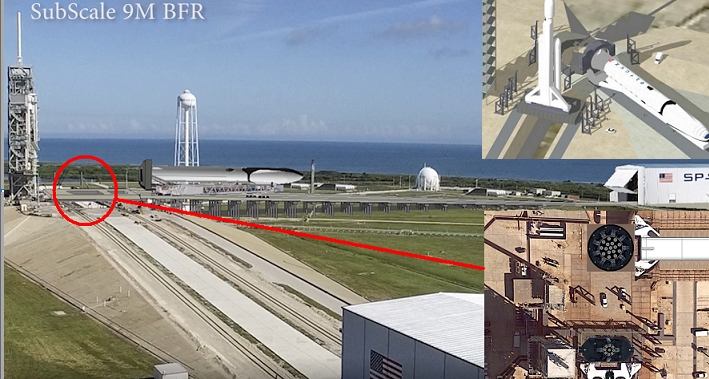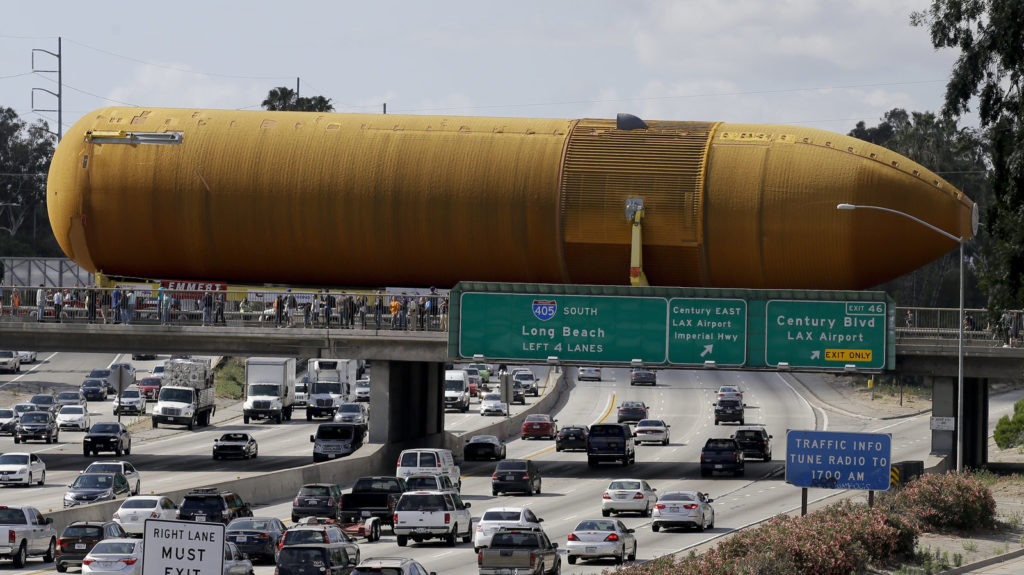

News
SpaceX considers Florida launch pad for both Falcon and Mars vehicle launches
Following a highly informative discussion at the ISS R&D conference, Elon Musk revealed that the updated, leaner version of SpaceX’s Mars architecture would likely have a diameter of around 9 meters.
A 9m Interplanetary Transport System, while precisely 25% smaller than the 12m diameter version revealed last year, would have to either lose the outer ring of full scale Raptor engines, or pivot to a smaller version of Raptor in order to preserve the 42 engine configuration shown at the IAC. Given Musk’s adamant and harsh judgement of the complexity of 27 Merlin 1D engines simultaneously firing on Falcon Heavy, moving to a 21 engine first stage for SpaceX’s Mars vehicle is a fair bet, so long as the full scale Raptor engine is still planned. Extremely speculative calculations based on the limited information available suggest that this smaller ITS could launch a bit less than half the payload of the original, still almost double the capability of Saturn V.
- A Space Shuttle’s external tank makes its way through downtown Los Angeles in 2011. The ET had a diameter of 8.4m. (AP/Chris Carlson)
- The base of SpaceX’s ITS booster, circa 2016. Current plans make it likely that the outside ring of engines will be subtracted and the vehicle made leaner. (SpaceX)
Possibly the most significant information to come out of this tweet is the implication that SpaceX and Musk are now looking to utilize current manufacturing facilities for the construction of a smaller ITS. While it adds considerable expense, the transport of a Space Shuttle’s external fuel tank through the streets of Los Angeles in 2011 sets a precedent for it being possible for SpaceX to transport a 9m vehicle from its factory in Hawthorne, CA to a nearby port. If SpaceX is able to use the same facilities it currently has for developing its Mars vehicle, it would experience immense savings compared to the cost of developing entirely new factories and testing facilities. This matches up perfectly with Musk’s repeated statement that the updated ITS is focused on improving the economic case for the vehicle and making it significantly cheaper to develop.
A 9m diameter vehicle fits in our existing factories …
— Elon Musk (@elonmusk) July 22, 2017
Possibly the most crucial keystone of this economical update relates to the launch pad or pads that will be necessary to launch a rocket as large as either ITS. An oft-overlooked feature of the current LC-39A launch pad SpaceX leases and operates in Florida is that it and its LC-39B sibling were developed with a far larger and more powerful version of Saturn V in mind, known as Nova at the time. SpaceX is well aware of this, and is also painfully aware of just how expensive the construction of launch pads can be after having to undertake deep repairs of LC-40.

Mockups of potential solutions for a dual vehicle setup at LC-39A. With this arrangement, SpaceX would be able to continue crewed and Falcon Heavy launches from the pad while conducting initial tests and launches of their ITS. (Jay Deshetler, in addition to Cameron Byers and John Archer, based on notes from KSC pad engineers)(NASASpaceflight)
Buried in a fascinating article by Chris Bergin of NASASpaceflight.com fame, Bergin has revealed that documents and rumblings behind the scenes indicate that SpaceX is seriously considering either co-launching from LC-39B or modifying LC-39A with a second launch mount. This would require considerably modifications to the venerable pad, but it would not require the costly and time-consuming construction of an entirely new launch pad. Speculative renders and mockups (above) created by the skilled forum members of NASASpaceflight demonstrate this nicely, showing the launch mount for ITS and Falcon side by side.
Combined with Musk’s past statements about this updated version of ITS, the future is looking increasingly bright for what was initially a somewhat crazy architecture. Easier transport, recycled development facilities, and co-location on an already-constructed launch pad show that SpaceX are completely serious about their ambitions for Mars and are willing to do what is necessary to get to the Moon, the Red Planet, and beyond.

Elon Musk
Tesla’s Elon Musk gives timeframe for FSD’s release in UAE
Provided that Musk’s timeframe proves accurate, FSD would be able to start saturating the Middle East, starting with the UAE, next year.

Tesla CEO Elon Musk stated on Monday that Full Self-Driving (Supervised) could launch in the United Arab Emirates (UAE) as soon as January 2026.
Provided that Musk’s timeframe proves accurate, FSD would be able to start saturating the Middle East, starting with the UAE, next year.
Musk’s estimate
In a post on X, UAE-based political analyst Ahmed Sharif Al Amiri asked Musk when FSD would arrive in the country, quoting an earlier post where the CEO encouraged users to try out FSD for themselves. Musk responded directly to the analyst’s inquiry.
“Hopefully, next month,” Musk wrote. The exchange attracted a lot of attention, with numerous X users sharing their excitement at the idea of FSD being brought to a new country. FSD (Supervised), after all, would likely allow hands-off highway driving, urban navigation, and parking under driver oversight in traffic-heavy cities such as Dubai and Abu Dhabi.
Musk’s comments about FSD’s arrival in the UAE were posted following his visit to the Middle Eastern country. Over the weekend, images were shared online of Musk meeting with UAE Defense Minister, Deputy Prime Minister, and Dubai Crown Prince HH Sheikh Hamdan bin Mohammed. Musk also posted a supportive message about the country, posting “UAE rocks!” on X.
FSD recognition
FSD has been getting quite a lot of support from foreign media outlets. FSD (Supervised) earned high marks from Germany’s largest car magazine, Auto Bild, during a test in Berlin’s challenging urban environment. The demonstration highlighted the system’s ability to handle dense traffic, construction sites, pedestrian crossings, and narrow streets with smooth, confident decision-making.
Journalist Robin Hornig was particularly struck by FSD’s superior perception and tireless attention, stating: “Tesla FSD Supervised sees more than I do. It doesn’t get distracted and never gets tired. I like to think I’m a good driver, but I can’t match this system’s all-around vision. It’s at its best when both work together: my experience and the Tesla’s constant attention.” Only one intervention was needed when the system misread a route, showcasing its maturity while relying on vision-only sensors and over-the-air learning.
News
Tesla quietly flexes FSD’s reliability amid Waymo blackout in San Francisco
“Tesla Robotaxis were unaffected by the SF power outage,” Musk wrote in his post.

Tesla highlighted its Full Self-Driving (Supervised) system’s robustness this week by sharing dashcam footage of a vehicle in FSD navigating pitch-black San Francisco streets during the city’s widespread power outage.
While Waymo’s robotaxis stalled and caused traffic jams, Tesla’s vision-only approach kept operating seamlessly without remote intervention. Elon Musk amplified the clip, highlighting the contrast between the two systems.
Tesla FSD handles total darkness
The @Tesla_AI account posted a video from a Model Y operating on FSD during San Francisco’s blackout. As could be seen in the video, streetlights, traffic signals, and surrounding illumination were completely out, but the vehicle drove confidently and cautiously, just like a proficient human driver.
Musk reposted the clip, adding context to reports of Waymo vehicles struggling in the same conditions. “Tesla Robotaxis were unaffected by the SF power outage,” Musk wrote in his post.
Musk and the Tesla AI team’s posts highlight the idea that FSD operates a lot like any experienced human driver. Since the system does not rely on a variety of sensors and a complicated symphony of factors, vehicles could technically navigate challenging circumstances as they emerge. This definitely seemed to be the case in San Francisco.
Waymo’s blackout struggles
Waymo faced scrutiny after multiple self-driving Jaguar I-PACE taxis stopped functioning during the blackout, blocking lanes, causing traffic jams, and requiring manual retrieval. Videos shared during the power outage showed fleets of Waymo vehicles just stopping in the middle of the road, seemingly confused about what to do when the lights go out.
In a comment, Waymo stated that its vehicles treat nonfunctional signals as four-way stops, but “the sheer scale of the outage led to instances where vehicles remained stationary longer than usual to confirm the state of the affected intersections. This contributed to traffic friction during the height of the congestion.”
A company spokesperson also shared some thoughts about the incidents. “Yesterday’s power outage was a widespread event that caused gridlock across San Francisco, with non-functioning traffic signals and transit disruptions. While the failure of the utility infrastructure was significant, we are committed to ensuring our technology adjusts to traffic flow during such events,” the Waymo spokesperson stated, adding that it is “focused on rapidly integrating the lessons learned from this event, and are committed to earning and maintaining the trust of the communities we serve every day.”
News
Waymo scrutinized after self-driving taxis cause traffic jams during SF blackout
It’s not farfetched to speculate that it would have been a doomsday scenario for Tesla had FSD behaved this way.

A power outage across San Francisco over the weekend forced numerous Waymo self-driving taxis to stop at darkened intersections and cause traffic blockages in multiple locations across the city. The disruption left riders stranded, frustrated drivers blocked, and city officials stepping in as the Alphabet-owned company temporarily suspended service amid the widespread gridlock.
Needless to say, it would likely have been a doomsday scenario for Tesla had FSD behaved in a similar way, especially if fleets of its robotaxis blocked traffic for numerous drivers.
Power outage halts Waymo fleet
The outage knocked out electricity for tens of thousands of customers, leaving traffic signals dark across large parts of the city, as noted in a report from the New York Times. Waymo vehicles began stopping at intersections and remained stationary for extended periods, seemingly unable to operate. Tow truck operators worked through the night removing immobilized vehicles, while videos circulated online showing Waymos with hazard lights flashing as traffic backed up around them.
Waymo later confirmed that it had paused its Bay Area ride-hailing service after the San Francisco mayor’s office contacted the company about the congestion its vehicles were contributing to. Service began coming back online shortly after 3:30 p.m. local time, though some users still reported being unable to request rides. Waymo maintained that no injuries or accidents were reported during the outage.
Autonomous cars during emergencies
The incident surprised industry observers since autonomous vehicles are designed to function during signal outages and temporary connectivity losses. Waymo stated that its vehicles treat nonfunctional signals as four-way stops, but “the sheer scale of the outage led to instances where vehicles remained stationary longer than usual to confirm the state of the affected intersections. This contributed to traffic friction during the height of the congestion.” Experts suggested the problem may have been linked to the vehicles’ reliance on remote assistance teams, which help resolve complex situations the cars cannot handle independently.
“Yesterday’s power outage was a widespread event that caused gridlock across San Francisco, with non-functioning traffic signals and transit disruptions. While the failure of the utility infrastructure was significant, we are committed to ensuring our technology adjusts to traffic flow during such events,” the Waymo spokesperson stated, adding that it is “focused on rapidly integrating the lessons learned from this event, and are committed to earning and maintaining the trust of the communities we serve every day.”










